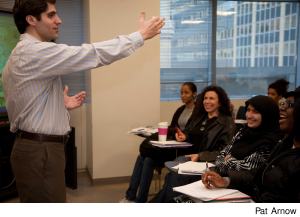During the week of March 28, BMCC Assistant Professor of Political Science Geoff Kurtz invited students in his four classes to discuss and debate a new topic: their own learning conditions.
In the discussions that followed, the students talked about the difference between smaller and larger class sizes, the value of having sufficient computers and other classroom equipment, and the impact of funding cuts on the quality of their education.
‘A USEFUL ROLE’
Kurtz also gave the students information about the debate over the New York State budget and how they could get involved. “It felt like a useful role for me to play, since most students don’t have the information,” Kurtz said.
Kurtz was one of more than 50 BMCC faculty members who participated in “Teach CUNY,” an initiative of the campus PSC chapter to promote student awareness of cuts in public funding for the City University and how the cuts affect their education. The participants found a variety of ways to integrate discussion about cuts in funding for CUNY into their classroom pedagogy.
Gail Mansouri, a doctoral lecturer in the social sciences department, teaches a course in American government and politics that combines traditional civics lessons with inquiries about the role of activism and social movements in creating change. When she talked about CUNY’s history as a free university and its current situation, the class’s previous discussions about the civil rights, suffragette and antiwar movements “became more real,” she said.
PLATO’S CAVE
“When you give students information about how other people have made change, they want to find out more about that,” Mansouri said.
 |
Teaching an English 101 class, Assistant Professor Frank Crocco drew on themes from “The Allegory of the Cave” in Plato’s The Republic in which the ancient Greek philosopher argues that the purpose of education is to turn people’s minds from illusory shadows dancing on the wall toward an appreciation of the truth. “The budget works perfectly with this theme,” Crocco said. “The students are generally uninformed about the cuts, the tuition increases and the context for these decisions, but would like to know more.”
“Teach CUNY” wasn’t just for those in the humanities or social sciences. During a remedial mathematics class, for example, Assistant Professor Kathleen Offenholley had students calculate the difference between the official rate of inflation and the faster rate at which their tuition was increasing.
For those students who want to take action to reverse the downturn in CUNY funding, an April 6 meeting of students and faculty provided an opportunity to discuss how to jumpstart student organizing at BMCC.
Thirty-six students and nine faculty members attended the April 6 meeting. By the end of a fast-paced 90-minute discussion, the students had created three committees – one for social media, another for tabling, and a third to organize a speakers’ bureau of students who would travel to various classes to make short presentations to their peers on the budget cuts and how to organize against them.
A student in Kurtz’s Introduction to Politics class, Leo Paulino, was selected to head the social media committee. He launched voicesofcuny.blogspot.com, a Facebook page, a Twitter account, and a YouTube account later that night.
“The most important thing is to get students informed. They don’t know what is happening,” said Paulino, a sophomore business administration major who works as a butcher and is the parent of a two-year-old child.
The idea of doing a “Teach CUNY” week was first raised at BMCC by Crocco. After the idea was formally approved at the chapter’s February 16 meeting, a group of 15 union activists set about reaching out to colleagues. They developed fact sheets and sample lesson plans and posted them online.
The pedagogical push was partly inspired by a PSC-wide “Teach
CUNY” week in 2001. That year one biology professor gave a lecture about the lab equipment his department could not afford, and what students would learn from the experiments he would assign if it were available. (Materials from 2001 are available online.)
CURRICULUM
“The people I spoke with were instantly receptive,” Kurtz told Clarion. “The main question was, ‘How can I get the information to make this substantive?’” Many saw connecting their curriculum to an issue that directly affects students’ lives as an important pedagogical tool.
The faculty members organizing “Teach CUNY” deliberately pursued a strategy of organizing through one-on-one conversations instead of blanketing their colleagues with e-mail announcements. After receiving an initial commitment, the organizers subsequently followed up with their colleagues to see if they needed any additional materials or other support to follow through on their plans.
“It was multiple personal conversations,” Kurtz said. “This wasn’t quick-hit mobilizing. Our chapter organized in a way that built connections among us and kept us accountable to each other.”
“I think we’re going to do this again,” added Crocco. “It allows us to engage mass numbers of faculty and students and bring them together for a common cause.”
______________________________
RELATED COVERAGE: PSC Opposes Mayor’s Devastating Cuts and Albany Budget Battle

